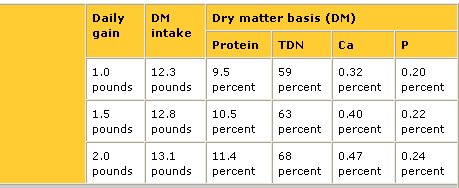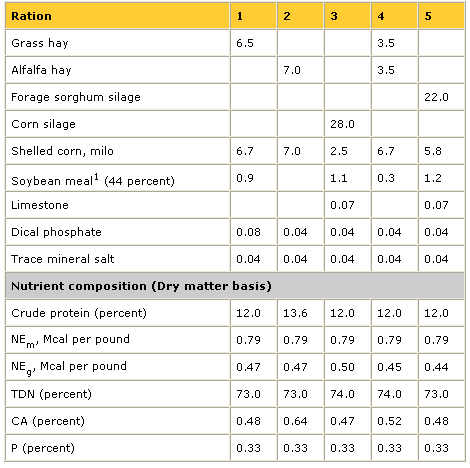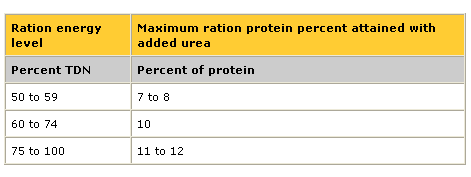



Winter Rations for Beef Calves
By David L. Lalman Department of Animal Sciences, University of Missouri - Stocker calves, weighing from 350 to 500 pounds, are wintered on a variety of rations on Missouri farms. The feedstuffs available and the desired rate of gain on the calves determine the ration.The first step in formulating a winter ration for your calves is to decide upon the daily rate of gain you want the calves to make. (Remember, weight gain is the product you have to sell.) Calves weighing 350 to 500 pounds will cost more per pound than calves will bring when sold at a heavier weight.
The only way the higher purchase price per pound can be offset is by putting on weight gains that cost less per pound than the selling price. Thus, you will likely want around 1.5 to 2.0 pounds daily gain on these calves during the winter. This is especially true if the calves are to be sold without going to grass in the spring. It takes less feed for a pound of gain at faster rates of gain because a smaller portion of the daily feed intake is used for body maintenance. Also, faster rates of gain help reduce the cost of high interest rates and other non-feed costs.
Medium to large-frame calves should not become too bloomy when gaining 1.5 to 2.0 pounds during the winter period. You may want to winter 350- to 500-pound calves to gain around 1.25 pounds daily if they are to be grazed on summer pastures without grain supplements. Cattle that are fleshy in the spring usually make poor rates of gain on summer pastures. Also, calves that have gained more slowly in winter will gain faster on pasture and thereby compensate for some of their lag in winter gain.
Nutrient requirements
The protein, energy and minerals required for a 500-pound calf to gain 1.0, 1.5 and 2.0 pounds daily are shown in Table 1. The level of these nutrients in some common feedstuffs are contrasted with these requirements. It is obvious that most of these feeds need protein, energy and mineral additions to satisfy the daily requirements of a 500-pound steers calf gaining 1.5 to 2.0 pounds daily.Table 1
Requirements for 500-pound medium-frame steer calf (NRC, 1984)


Supplying adequate supplementation at the least cost for farm-grown feeds is the key to economical winter gains. The nutrient composition of roughages varies widely, so a laboratory test to measure the nutrient levels in your feeds will greatly improve your ration formulations. Some rations for 500-pound calves to gain 1.5 and 2.0 pounds daily are given in Tables 2 and 3.
Table 2
Rations for 500-pound steers to gain 1.2 to 1.6 pounds daily (pounds per head per day)

1An equivalent amount of commercial protein supplement can be substituted for the soybean meal. It should be high in natural protein for this weight cattle. These rations should have 20,000 IU of vitamin A added to the per head daily feed allowance. See the text for the value of implants and additives (Rumensin®, Bovatec®, MGA®, and antibiotics).
Table 3
Ration for 500-pound steer to gain 2.0 pounds daily (pounds per head per day)

1An equivalent amount of a commercial protein supplement can be substituted for the soybean meal. It should be high in natural protein for this weight cattle. These rations should have 20,000 IU of vitamin A added to the per head daily feed allowance. See text for the value of implants and additives (Rumensin®, Bovatec®, MGA®, and antibiotics).
Protein supplements
Plant protein supplements usually give greater performance than urea or other non-protein nitrogen supplements for calves weighing under 600 pounds and for cattle first started on feed. This is because light-weight cattle have less rumen capacity to produce microbial protein. Also, they need higher protein levels in their diet than older, heavier-weight cattle.High-energy rations are better suited to the use of non-protein nitrogen supplements because energy can limit microbial fermentation in the rumen. Table 4 gives a rule of thumb for the level of crude protein equivalent that can be attained in a ration with non-protein nitrogen additions on the basis of the energy level in the ration. The urea fermentation potential of these rations has been estimated. Notice that even a ration that has a level of TDN (Total Digestible Nutrients) similar to corn silage (70 percent) has a urea fermentation potential to raise the crude protein level of the ration dry matter to about 10 percent, which is still below the protein requirement for a 500-pound calf gaining 1.5 to 2.0 pounds daily (10.5 to 11.4 percent).
Table 4
Urea trials1

1NRC, 1976
Still, some urea can be advantageous in supplements for young cattle where the ration has a large amount of protein bypassing the rumen and there is a scarcity of ammonia in the rumen for the microbes. Urea breaks down to supply ammonia in the rumen. In some studies, combining urea with slowly degraded protein sources, such as distiller byproducts and blood meal, has been superior to soybean meal in the ration of young calves. These supplements have been called high bypass protein supplements.
Corn silage rations
A full feed of good quality corn silage supplemented for protein, minerals, and Vitamin A will produce from 1.5 to 1.8 pounds of daily gain on a 400- to 500-pound calf. Some grain additions will usually be needed to get 2.0 pounds daily gain. In a University of Minnesota trial, adding 3 pounds of high moisture corn per head daily to calves full fed corn silage increased daily gain in the growing period from 1.60 to 1.90 pounds and decreased the time to slaughter by 10 to 15 days.It takes about 1.1 to 1.3 pounds of a 40 percent protein supplement per head daily to supplement the corn silage intake of 400- to 500-pound calves (Tables 2 and 3). However, 1 pound of soybean meal appeared to be adequate for corn silage used in Kentucky studies with 400-pound steer calves.
Non-protein nitrogen-treated silage
Corn silage treated with urea or anhydrous ammonia at ensiling to raise the protein content to 11 to 12 percent (dry matter) will need little additional protein for growing calves or yearlings. Non-protein nitrogen (NPN) added at ensiling gives equal or slightly better performance than adding urea supplements to silage at feeding time. Most studies indicate that plant protein supplements give slightly better performance than NPN additions to rations for cattle weighing less than 600 pounds. Non-protein nitrogen compounds are a cheaper source of protein than soybean meal and can give cheaper cost of gain than plant protein supplements, especially for heavier-weight cattle that have no reduction in performance when NPN supplements replace plant protein supplements in their diet.Feed a 450-pound calf 1 pound of soybean meal daily for the first 30 days when full-fed NPN-treated silage that has 12 to 13 percent protein on a dry matter basis. If the protein in the silage is 11 percent, feed 1.2 pounds of soybean meal per head for the first 30 days and then reduce to 0.5 pound until the cattle weigh around 650 pounds. You may wish to substitute a commercial protein supplement that furnishes as much natural protein as is contained in these amounts of soybean meal.
Alfalfa
Alfalfa or other high-quality legume hay, silage, or haylage can be used to supplement corn silage for protein in the ration of calves. It will take 3.5 to 4.5 pounds of alfalfa hay to supply the amount of protein contained in 1.2 to 1.5 pounds of soybean meal. Rate of gain will usually decline slightly when alfalfa is substituted for soybean meal in corn silage rations for growing 500- to 700-pound calves. This is because alfalfa hay has less energy than the soybean meal and corn silage it replaces. However, alfalfa can reduce the cost of growth gains, since it may be cheaper than silage and oil meals as a source of protein and energy.Other silages
Forage sorghum, small grain and grass legume silages work well for wintering calves but are lower in energy than corn silage. It will take about 0.5 pounds of grain per 100 pounds of body weight per head daily in the ration for grass-legume silage or haylage to give similar rates of gain to a full feed of corn silage. Protein will be adequate if the legume silage furnishes 40 percent of the ration dry matter.Wheat silage has 2 to 3 percentage points more protein than corn silage in its dry matter. Wheat silage is lower in energy than corn silage and will need 2 to 3 pounds more grain fed per head daily with it to give performance equal to corn silage for 400- to 600-pound calves. About 0.7 pounds of soybean meal a head daily or its equivalent in other supplements in wheat silage rations will supply the protein needed for 400- to 600-pound calves.
In general, a full feed of forage sorghum silage and 4 pounds of a soybean meal-grain supplement a head daily has given 1.7 to 2.0 pounds daily gain for 450- to 500-pound calves fed 125 days. About 2 pounds of the daily supplement was soybean meal. The energy level of forage sorghum silage is proportional to the amount of grain in the silage. Grain sorghum silages have feed value very close to corn silage.
Grass and legume hays
Hay varies greatly in quality and a feed test should be made to indicate the protein, energy and minerals in the hay. Late-cut grass hays or those with much weather damage will need both protein and energy added to produce 1.5 pounds daily gain on weanling calves.In an Ohio trial, 350-pound steers wintered outside on pasture containing round bales of orchard grass with some alfalfa, gained 1.65 pounds daily when fed 5 pounds of a protein-mineral mixture containing 2/3 corn. It took 11 percent salt in the concentrate mixture to hold consumption to 5 pounds per head daily.
Ammoniated roughages
Wheat straw, corn stalks and late-cut, low-quality hays are too low in energy and protein for wintering calves. Sealing these low-quality roughages under plastic and treating them with 60 pounds of anhydrous ammonia per ton (3 percent of dry matter) has doubled the protein content, increased dry matter digestibility by 10 to 12 percentage points and increased dry matter consumption by 10 to 25 percent. This improvement in quality makes straw or corn stalks about equal to a medium-quality grass hay as feed for cattle.Winter fescue pasture
Stockpiled tall fescue pasture, along with big hay bales, is frequently used to winter calves and light-weight yearling cattle. The nutrient quality of the stockpiled fescue declines after the first of January because nutrients leach from the plant cells.In a 3-year study at the University of Missouri, 450- to 500-pound steer calves averaged 0.7 pounds of gain daily on stockpiled tall fescue pasture, supplemented with fescue hay and limited amounts of cracked corn when snow-covered. Calves will usually need 4 to 5 pounds of a grain-protein mixture per head daily to average 1.2 pounds daily gain on winter fescue pasture (Table 2).
Wheat pasture
Wheat pasture has 20 to 30 percent crude protein on a dry matter basis. In winter, it may drop to 20 percent, but it will be around 30 percent when it is growing rapidly in fall or spring. These levels of protein are more than is needed by calves, so protein supplements are not necessary. Energy is more likely to be limiting for calves on wheat pasture. Wheat pasture is often quite low in calcium (0.02 percent), high in phosphorus and marginal or low in magnesium. Thus, calcium and magnesium levels should be emphasized in mineral supplements for calves on wheat pasture. Free-choice mineral supplements should have 6 to 8 percent magnesium. You may need to mix 10 to 25 percent dried molasses in these high magnesium supplements to get around 2 ounces a day intake.Typical stocking rates are 0.75 to 1.75 head per acre of 400- to 500-pound calves in the fall and winter, depending upon growth, stand, and soil fertility. This can be doubled to 1.5 to 2.5 head per acre in the spring if the wheat is grazed out. Figure about two-thirds of these numbers per acre of 600- to 700-weight cattle. The wheat must be stocked heavy enough in the spring to keep up with forage growth and prevent jointing if it is to be grazed out. Typical gains of steers on wheat in spring are 1.5 to 2 pounds daily. Heifers will gain about 10 percent less.
Bloat can be a problem on wheat pasture. Regular feeding of some hay, silage or grain will help. The most effective prevention of bloat is Bloat Guard® (Poloxalene). Bloat danger is greatest the first two to four weeks of rapid wheat growth in the spring. The Bloat Guard® might be fed at this time. Feeding 150 to 200 mg. of Rumensin® or Bovatec per head daily in a supplement will give some protection against bloat and increase the daily gain of cattle on wheat pasture by 0.2 pounds.
Wastes and byproducts
Poultry litter is high in protein and minerals. A mixture of 50 percent broiler litter and 50 percent ground corn fed free-choice to calves will produce from 1.5 to 2.0 pounds daily gain.Liquid whey is available in some parts of the state for cattle feed. Cattle can consume up to 30 percent of their dry matter intake of whey without reduction in their performance. This would represent an intake of 50 to 60 pounds daily of liquid whey for a 500-pound steer. Whey can supplement hays for protein, calcium and phosphorus.
Distiller slops and grains are another possibility for protein and energy sources in winter rations. Byproduct feeds like soybean hulls and corn gluten feed don't decrease the digestibility of the forage to the extent that corn or other high-starch grains do when fed at the rate of 3 or more pounds per head daily with forages. This is because most of the energy in soyhulls and corn gluten feed is derived from highly digestible fiber and thereby does not cause the depression of the fiber-digesting bacteria in the rumen that is the case with the high-starch grains. Even though soy hulls and corn gluten feeds are somewhat lower than corn grain in energy, they often add as much or more energy to the total mixed ration because of less negative effect in the energy contributed by the forage.
Implants, feed additives, and antibiotics
Ralgro®, Synovex®, Compudose® or Steer-oid® implants will increase the rate and efficiency of gain of 400-pound-plus calves, especially if the calves are gaining over 1 pound daily. Implants can improve rate of gain by as much as 0.25 pounds daily in a winter period.Feeding 150 to 200 milligrams of an ionophore (Rumensin® or Bovatec®) per head daily has increased the average daily gains of steers and feeder calves on growing rations and pasture by 0.20 pounds daily. When both Rumensin® and implants are used, the total increase in gain and feed savings is greater than the response from either used alone. MGA® is a feed additive that increases rate and efficiency of gain of heifers. MGA has been approved for mixing in the same supplement with an ionophore (Bovatec or Rumensin). A combination of the two has given a greater response in heifer than when either additive is fed alone.
Minerals and vitamins
About 20,000 IU of Vitamin A per head daily should be included in all of these winter rations for calves.Phosphorus is most likely to be deficient in hay rations. Adding grain will increase the phosphorus content. Potassium should be adequate in most hays but can be deficient in late winter in stockpiled tall fescue.
If grass or legume hays are fed alone, a free-choice mineral supplement should have about 10 to 12 percent phosphorus. If 1 percent of the body weight in corn is fed, the phosphorus could be reduced to 5 percent in the free-choice mineral.
January 2007



